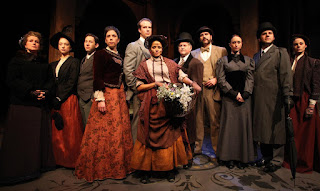George Bernard Shaw’s Pygmalion shows us three very different family units. We’ve already peeked behind-the-scenes at the trio of secondary characters that make up the Eynsford-Hill family. The next family is the Doolittles: Eliza and Alfred. While the two characters are family, they share little stage time together, and the particulars of their relationship are left up to the actors playing them. We caught up with our actors backstage before the show one day.
SOLITARY LIFESTYLES

“I don’t think that the characters really have much of a relationship,” says Stage Left Ensemble Member Mark Pracht, who plays Eliza’s father, Alfred Doolittle. “It says in the script he hasn’t seen her in two months, and I don’t think that’s unusual. I have it in the back of my head that Alfred has, like, 28 kids that are all running around London and he hardly sees any of them.”
“Her falling in with Higgins is just an opportunity for him to suck some money off of somebody. I think that’s just of the nature of that family, at least from Alfred’s perspective. He lives for himself. He doesn’t want to take care of a kid. If forced to he will, but he doesn’t really want to. So the fact that Eliza is able to take care of herself with selling flowers means he doesn’t have to deal with her.”
Stage Left Ensemble Member Mouzam Makkar, who plays Eliza, concurs. “I feel like Father Doolittle was just this remote presence in the household. She does tell the story of “my aunt died of influenza, but my father, he kept ladling gin down her throat…” So I feel like he was around, but they didn’t really talk. But I knew he was my dad and he would come by sometimes and-“
“And ask if you have money,” chimes in Mark.
“Exactly,” says Mouzam. “I feel that was pretty much the extent of the relationship.”
AN OPPORTUNISTIC STREAK

”Early on in the show, I’m doing a lot of just touching things, because I feel like Eliza probably hasn’t touched, for instance, nice engraved wood or plush couches, and I just totally imagined her being very sensory and touching and smelling things.”
-Mouzam Makkar
Still, the two characters came from the same neighborhood and the same class structure, and even if they didn’t have much interaction, they do share some familial similarities. “There is a certain assertiveness to the characters,” admits Mark. “The ability to just walk into the Higgins household and ask for what they want— that takes a certain disdain for the class structure. They’re both very opportunistic people. I think that’s probably on the Doolittle coat of arms: ‘Do for yourself.’”
Mouzam agrees. “Yeah, Doolittle is a smart guy, he knows where his strengths are, he knows what he can do, and I feel like Eliza knows what she is capable of too.” This is aptly demonstrated in the first scene of the play, in which Eliza rallies the crowd to her defense when she feels she might be arrested. “They both know how to manipulate a situation. They’re not strangers, she just knows ‘this is how I do my thing and this is how he does his.’”
COSTUMES AND BEARDS

“The interesting thing about Alfred’s argument as to why he should be given the money for Eliza is really hilarious to me, because at the time the concept of a dowry was pretty common, and I think that’s the way he looks at it: you’re taking my daughter, and that means you give me some money. He’s adept at using the society against itself.
-Mark Pracht
Mouzam and Mark are each drawn to their characters for different reasons.
“I love how strong Eliza is,” says Mouzam. “And it’s a role that kind of scared me at first, and I thought that meant I should probably audition for it. Because how often do you get the chance to say, ‘If get this role, then crap— I’m going to need to really figure this out and work hard at it!’”
For his role as Alfred, Mark has been specifically highlighted in many reviews, such as in the Chicago Sun-Times, which noted that he “mines every ounce of the comedy and self-awareness in Eliza’s dad.”
“I describe it as sort of a paratrooper role,” muses Mark. “You drop in, you say some funny stuff, and then you leave. And that’s always fun to do. You don’t have to carry the show.” No, but he certainly steals every scene he’s in. “I would never say I do that,” he demurs.
For this role, Mark grew an impressive set of friendly mutton chops, a style in which the mustache and side burns are connected. “In the last couple of years, I’ve been lucky enough to do parts that required me to do fairly extensive makeup, of one kind or another, and I really enjoy that,” Mark comments fondly. “I enjoy the idea of looking in the mirror and being about to go onstage and not seeing me, but just seeing the character. That’s also why I enjoy getting the costume. Thing don’t really come together for me until then.”
Speaking of costumes, Mouzam undergoes no less than five complete costume changes in the course of the two hour show. The evolution of these costumes also helped inform her acting choices. “The first costume I wear is so bulky and I can just slouch and be on the ground and I don’t think about ‘is my skirt set right?’ Plus I get to put dirt on my face and have scraggly hair. That really helps define early Eliza.”
“And then I get to do a slow transformation, where I take the dirt off first, and then I put all of my hair up, which makes me think, ‘oh, I don’t have anything on my shoulders now, this is nice,’ and then I get to put on the nice dress. My dresses get more and more constrained as the evening goes on, and that really does help me get to the point at the end where I’ve become a lady.”
You can see the Doolittles in action in BoHo and Stage Left Theatres’ joint production of Pygmalion, now playing at Theater Wit until February 10th. Do you have thoughts on the characters or our actors’ approach to them? Leave a comment below and join the conversation!















